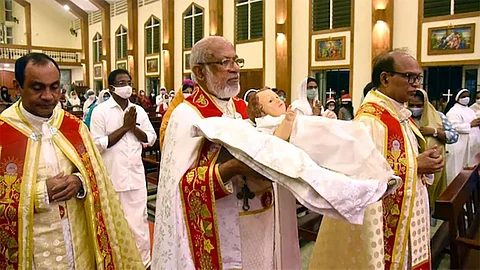
- HOMEGROWN WORLD
- #HGCREATORS
- #HGEXPLORE
- #HGVOICES
- #HGSHOP
- CAREERS
- ABOUT US
- CONTACT US

As the end of the year nears and Kolkata lights up in Christmas colours, I am thinking about how Christmas is celebrated across India. From the celebrations at the Bow Barracks in Kolkata to the storefront displays in Bandra and lavish Christmas feasts in Goa, Indians celebrate Christmas with great pomp and passion across the country. It's one of the things that I love about India. Our immense potential for joy, happiness, and community and our love for celebration knows no limits.
Over the years, I've had the privilege and the pleasure of experiencing this intimately. As I sit at my home in Kolkata now, I'm thinking about the Christmas I got to spend in Kerala, at a Syro-Malabar Christian friend's home in Kochi. It was in the early-2010s, and I was still a teenager. It was a transformative experience.
The Syro-Malabar Christians are one of the oldest Catholic denominations in the world. They trace their origins to Saint Thomas, the Apostle — one of the twelve disciples of Jesus according to the New Testament. The story goes like this:
Sometime in the second half of the 1st century CE, Saint Thomas travelled outside the Roman Empire to preach the Gospel, reaching as far as Kerala in South India. In 52 CE, he arrived at the seaport of Muziris — near modern-day Kodungalloor — and established seven great churches along the Malabar coast during his missions in South India. Following his footsteps came East Syrian settlers and Persian missionaries, members of what would later become the Church of the East, in the 3rd century CE. The Syro-Malabar Christian community, also known as the Saint Thomas Christians, grew from the Indians Saint Thomas converted and the 3rd-century settlers and missionaries from Syria and the Middle East.
Today, the Syro-Malabar Church is the second largest sui juris church within the communion of the Catholic Church after the Latin Church. The Syro-Malabar Christians are unique among Catholics for their distinct traditions and practices. The liturgical language of the Syro-Malabar Church is Syriac — a dialect of the ancient Aramaic language of Syria spoken in the Near East between 6th and 7th centuries CE.
The Christmas traditions of the Syro-Malabar Christians are also unique to their denomination.
In preparation for the Feast of the Nativity, Syro-Malabar Christians practise abstinence for 25 days of 'Lent' leading up to Christmas. On Christmas Eve during the Nativity liturgy, instead of blessing the new candle, they observe the blessing of fire with a warming ceremony unique to the community.
The Christmas eve liturgy of the Syro-Malabar Church begins outdoors rather than indoors, incorporating the Nativity scene into the Holy Mass — a ritual based on the idea that it's a cold night outside and the procession is taking the divine infant indoors to keep him warm.
The Syro-Malabar Christians follow the ritualistic practices of both the Eastern and Western Churches, but also draw from the regional traditions of ancient Syria and India. This synthesis of indigenous and introduced, adopted practices on one hand, and non-Christian and Christian traditions on the other, has led to the emergence of a multi-faceted interpretation of the faith that is truly unique to the community and represents some of the most interesting Christmas celebrations in India and the world.
So, if you ever find yourself in Kerala during Christmas, don't forget to drop by a Syro-Malabar Christmas celebration and say hello; or better yet: Christmas Ashamsagal!
If you enjoyed reading this, here's more from Homegrown:
A Homegrown Guide To Celebrating Christmas In Kolkata
The Story Behind Bandra’s Iconic Damian Store Christmas Displays
Plum Cakes & Parties: Our Very Merry Guide To Christmas In Bandra
